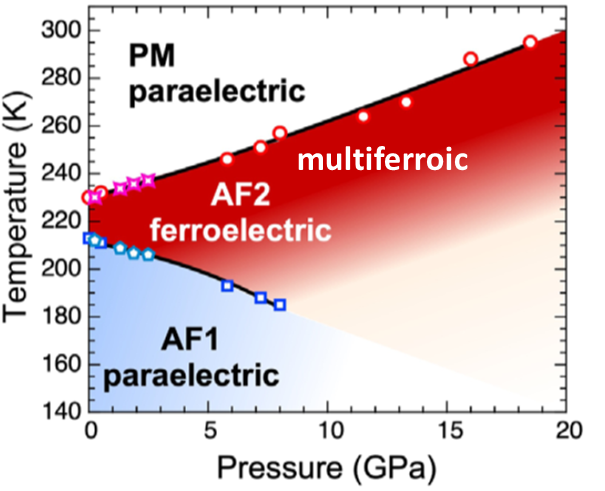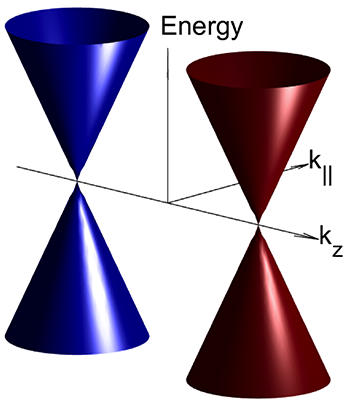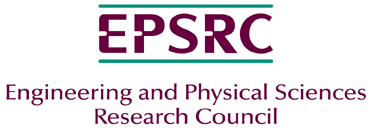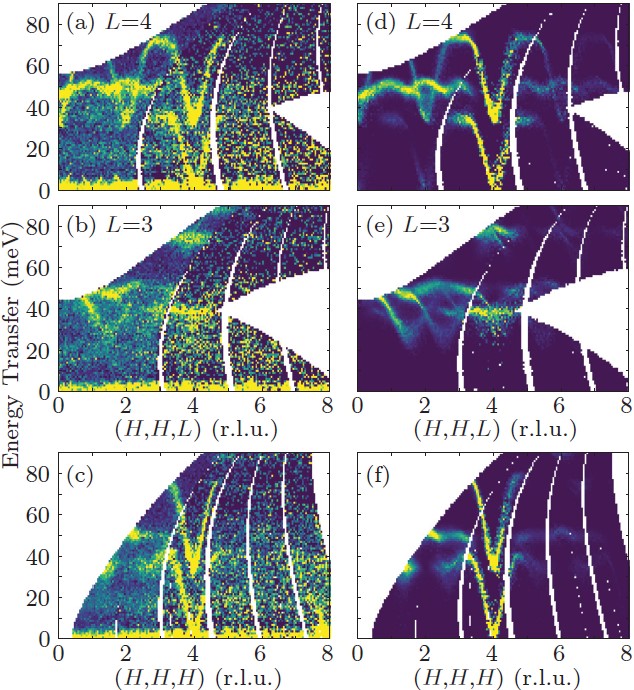
●
Axion electrodynamics in a topological insulating crystalWorking alongside international collaborators, we have identified a crystalline solid which satisfies the requirements to host an exotic axionic electrodynamic field. The work could make it possible to observe axion-like quasiparticles in the solid state, as well as laying the ground for a new type of dark matter detector.
Axions are a type of fundamental particle first proposed in 1977 to resolve the so-called strong CP problem in the Standard Model of particle physics. Axions have also emerged as one of the prime candidates for the dark matter required to account for the missing mass in the Universe. So far, however, axions have yet to be observed in nature.
Recently, several theoretical studies have predicted that a quantized axion field that is absent from the usual Maxwell’s equations in media can occur within certain three-dimensional crystals, called axion insulators. The electronic spectrum of such a material is insulating within the bulk and on the surface due to an inversion of the electronic states relative to the atomic energy levels combined with magnetic order. To create the necessary condition for the axion field to exist, the magnetic order must satisfy stringent symmetry conditions.
The team, which included Professor Andrew Boothroyd and Dr D Prabhakaran, as well as two former Oxford Physics DPhil students, Dr Jian-Rui Soh and Dr Marein Rahn, investigated a compound containing europium, indium and arsenic, with chemical formula EuIn2As2. They performed resonant x-ray scattering experiments at the Diamond Light Source, near Oxford, and at the PETRA-III facility in Hamburg, to study the magnetic pattern adopted by the europium electrons at low temperatures.
The experiments showed that magnets attached to the europium atoms self-organise into an unusual type of helical pattern, like a screw thread, which undergoes a scissor-like motion as the temperature increases. The team developed a theory that low energy vibrations of the helix cause the change in the structure with temperature. Importantly, the magnetic helix established in the experiments possesses the symmetries required for EuIn2As2 to be an axion insulator.
Reference:
Jian-Rui Soh et al., Nature Communications 14, 3387 (2023)
●
Pressure stabilizes delicate electromagnetic state at room temperatureIn research carried out in collaboration with partners at the ISIS Facility and in Japan, we have discovered that a subtle magnetic and electric hybrid response that is observed in some magnetic insulators can be strongly enhanced by the application of pressure. The results help to explain the underlying mechanism, and point to ways in which materials showing the effect can be improved.
Magnetic multiferroics are materials having the property that magnetic order can induce a ferroelectric polarisation. Multiferroic materials have potential applications in electromagnetic sensors, actuators and in memory devices. One limitation on the uses of multiferroic materials is that the multiferroic effect usually occurs only at temperatures that are well below room temperature.
We studied cupric oxide (CuO) by neutron diffraction at the ISIS Neutron and Muon Source. The sample was squeezed in a Paris-Edinburgh cell with diamond anvils that were specially designed for use on neutron beamlines. At atmospheric pressure, cupric oxide exhibits a multiferroic phase with helical magnetic order over a small temperature range from 213 K to 230 K. Consistent with theoretical predictions, the onset temperature of the multiferroic phase was observed to increase with increasing applied pressure until at a pressure of 18.5 GPa the phase becomes stable at room temperature (295 K).
Reference:
Noriki Terada et al., Phys. Rev. Lett. 129 (2022) 217601
●
Discovery of an ideal Weyl semimetalWeyl semimetals exhibit exceptional electronic transport due to the presence of topological band crossings called Weyl nodes. The nodes come in pairs with opposite chirality, but their number and location in momentum space is otherwise material-specific.
Together with colleagues in the Rudolf Peierls Centre for Theoretical Physics, Oxford, and a team of international collaborators, we have found that intermetallic EuCd2As2 in a magnetic field is what Bernevig has termed the hydrogen atom of a Weyl semimetal, i.e. one with a single pair of Weyl nodes at the Fermi level and without overlapping electron bands.
The discovery opens the door to exploration of a wide range of exotic physics predicted for Weyl fermions in the solid state.
Reference:
J.-R. Soh et al., Phys. Rev. B 100 (2019) 201102(R)
●
New EPSRC grant:Title: A state-of-the-art floating-zone furnace for crystal growth at high pressures
Investigator(s): A. T. Boothroyd, D. Prabhakaran, P. G. Radaelli, I. A. Walmsley
Reference: EP/R024278/1
Value: £893,916
Start date: 1 March 2018
Duration: 2.5 years
●
Understanding the magnetic properties of YIGResearchers from the University of Oxford have for the first time mapped the complete spectrum of magnetic oscillation modes in yttrium iron garnet (YIG). The results are important for understanding magnon transport phenomena in YIG which are being exploited in a variety of potential magnonic applications.
YIG is already used in a broad range of technological devices, from microphones to lasers. However, it is also key to the emerging field of magnonics, which seeks to create devices that replace conventional electrical circuitry with magnetization currents. If YIG is to fulfil this potential, its magnetic properties, particularly at room temperature, need to be well understood.
Andrew Princep, D. Prabhakaran and Andrew Boothroyd, together with colleagues from the ISIS Facility, the Paul Scherrer Institut and the German technology company Innovent, used inelastic neutron scattering to measure the full magnon spectrum of a large crystal of YIG, and used advanced modelling software to determine values for the exchange interactions between the spins.
The results have been used to develop a model which can be applied to understand and predict the magnetic behaviour of YIG over a wide range of temperature, including the operational conditions for YIG-based magnonics devices.
Reference:
A. J. Princep et al., npj Quantum Materials 2, 63 (2017)
●
All-in-all-Out magnetic order established in a candidate Weyl semi-metalAn international team from Oxford and UCL has shown that an iridium oxide compound satisfies a necessary requirement for a correlated Weyl semi-metal. The finding points the way to a possible realization in the solid state of an exotic type of particle.
The Weyl semi-metal is a topologically non-trivial electronic state described by a solution to the Dirac equation for massless fermions. It requires the combination of either (i) time-reversal symmetry with broken inversion symmetry, or (ii) inversion symmetry with broken time-reversal symmetry. Examples of the former type of Weyl semi-metal have been found recently, but no example of the latter has yet been confirmed.
The team, which included Marein Rahn, Dr D Prabhakaran and Prof Andrew Boothroyd from Oxford, used a combination of resonant elastic and inelastic X-ray scattering on single crystal samples grown in Oxford. The results showed that the cubic pyrochlore oxide Sm2Ir2O7 transforms at a temperature of 110K into a magnetically ordered state in which the magnetic moments on the Ir atoms point either all-in or all-out of a network of tetrahedra formed by the Ir sites in the crystal. Such a magnetic structure breaks time-reveral symmetry but preserves inversion symmetry, as required for a Weyl semi-metal.
The results support a theoretical prediction that the family of pyrochlore iridates may host Weyl fermions, although electronic correlations also revealed by the study could forestall the Weyl semi-metal state. In that case, it might be necessary to tune the electronic structure by chemical modifications or external perturbations to form the Weyl semi-metal.
Reference: C. Donnerer et al., Phys. Rev. Lett. 117, 037201 (2016) (arXiv:1604.06401)
●
New EPSRC grant:Title: New correlated electronic states arising from strong spin-orbit coupling
Investigator(s): Prof. A. T. Boothroyd and Dr D. Prabhakaran
Reference: EP/N034872/1
Value: £488,109
Start date: 1 November 2016
Duration: 3 years






Prof. Andrew Boothroyd
Clarendon Laboratory
Oxford, OX1 3PU
United Kingdom
phone
+44 (0) 1865 272376
fax
+44 (0) 1865 272400